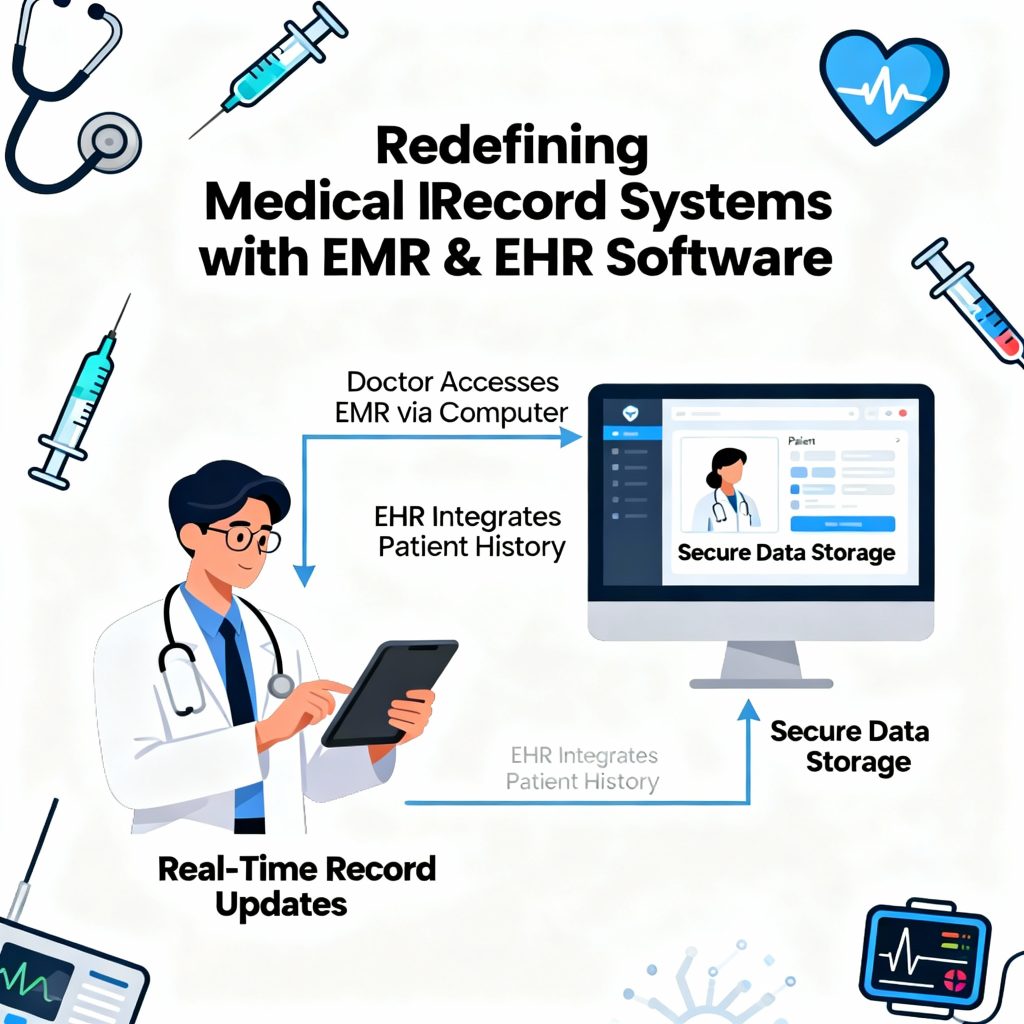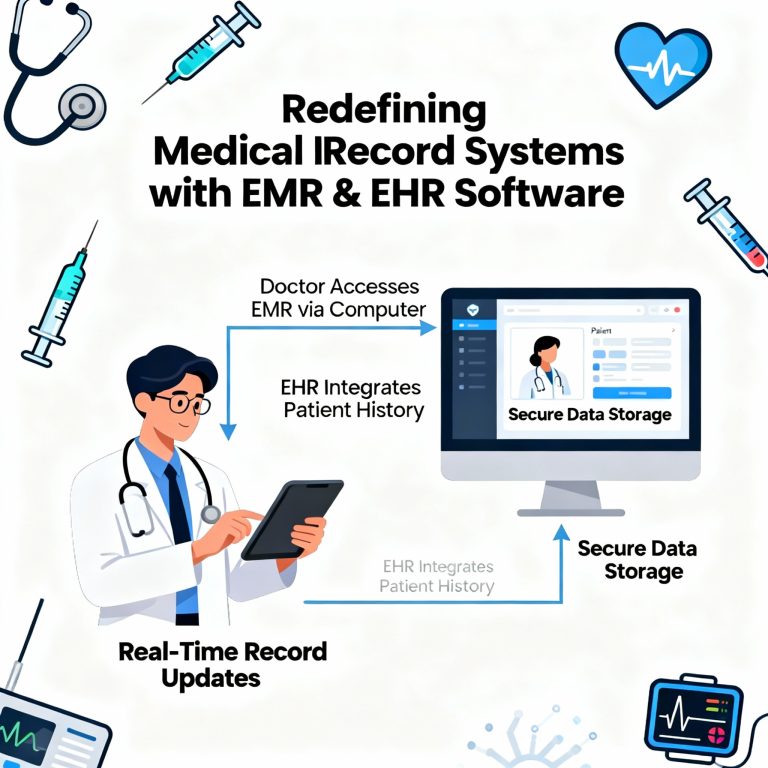The healthcare industry has experienced a massive digital transformation over the last decade. Among the many advancements, EMR software and EHR Software Systems have revolutionized the way patient data is stored, accessed, and shared. As hospitals and clinics continue to modernize their operations, the role of electronic health record systems has become more important than ever. These systems not only improve patient care but also simplify administrative processes, making healthcare delivery faster and more efficient.
Understanding EMR and EHR Software
Before diving deeper, it’s crucial to understand the difference between EMR software and EHR Software Systems.
EMR software (Electronic Medical Records) is designed primarily for use within a single healthcare facility. It contains the digital version of a patient’s chart, including medical history, diagnoses, prescriptions, and treatment plans. Essentially, it replaces traditional paper-based records with secure, easily accessible digital data.
On the other hand, EHR software (Electronic Health Records) offers a broader and more integrated approach. Unlike EMR, EHR can share patient data across multiple healthcare providers and organizations. This allows doctors, specialists, and pharmacies to access real-time information, ensuring continuity and accuracy in patient care.
The Growing Importance of Electronic Medical Record Systems
Today, electronic medical record systems have become an essential part of healthcare infrastructure. They are not just tools for storing patient information but comprehensive platforms that enhance communication, security, and clinical decision-making.
With Electronic Medical Record Service providers offering scalable and cloud-based solutions, healthcare institutions can now manage patient data more effectively than ever. Moreover, these systems support healthcare professionals in diagnosing conditions faster, reducing errors, and improving patient safety.
Additionally, regulatory bodies and governments across the world are encouraging healthcare providers to adopt electronic medical records to promote data standardization and interoperability. As a result, hospitals and clinics that have integrated EMR and EHR systems are experiencing smoother workflows and improved patient satisfaction.
How EMR and EHR Software Are Redefining Healthcare Operations
The introduction of EMR software and EHR Software Systems has significantly redefined healthcare management. Let’s explore how these systems are transforming traditional healthcare practices into efficient digital ecosystems.
1. Streamlined Data Management
Firstly, one of the most significant benefits of electronic health record systems is their ability to streamline data management. Instead of maintaining physical files, medical staff can easily access digital records within seconds. Furthermore, all updates, test results, and prescriptions are stored systematically, reducing the risk of misplaced information.
2. Enhanced Patient Care
Secondly, both EMR software and EHR software enable better coordination among healthcare providers. For instance, if a patient visits multiple specialists, each doctor can access the same up-to-date medical record. This not only saves time but also ensures accurate diagnoses and treatments. Additionally, patients benefit from faster consultations and reduced duplication of tests.
3. Data Accuracy and Security
Moreover, electronic medical records minimize the chances of human errors that are common with paper-based documentation. With features like data encryption and role-based access, Electronic Medical Record Service providers ensure that sensitive information remains secure. As a result, healthcare institutions can maintain compliance with data protection laws while building patient trust.
4. Improved Efficiency and Cost Savings
Because digital systems automate repetitive administrative tasks such as appointment scheduling and billing, healthcare professionals can focus more on patient care. Additionally, using EMR software helps reduce the need for physical storage and paper costs. In the long run, hospitals experience higher productivity and lower operational expenses.
5. Real-Time Data Access
Importantly, electronic health record systems provide real-time access to patient data. Whether it’s a doctor reviewing lab reports or a pharmacist checking prescription details, information is readily available. Consequently, decisions can be made faster, leading to better clinical outcomes.

The Role of EMR and EHR Software in Modern Healthcare
With technology becoming an integral part of medical care, EMR software and EHR software have become indispensable tools. They not only improve healthcare delivery but also help institutions adapt to the growing demand for digital efficiency.
In addition, Electronic Medical Record Service providers are constantly innovating, offering AI-powered insights and predictive analytics. These features allow doctors to identify health risks early and provide proactive care. Moreover, with the rise of telemedicine, EHR integration ensures that online consultations are as effective as in-person visits.
Benefits for Patients and Healthcare Providers
The transformation isn’t limited to hospitals and clinics. Patients, too, benefit from electronic medical records in several ways. For example, they can access their medical history through secure patient portals, schedule appointments online, and receive reminders for checkups.
From a provider’s perspective, EHR software improves communication between different departments and reduces redundant paperwork. Furthermore, it enhances clinical decision support by offering real-time alerts for drug interactions or abnormal lab results.
Challenges and the Way Forward
Although electronic medical record systems have many advantages, their implementation isn’t without challenges. Some healthcare institutions still struggle with data migration, staff training, and system integration. However, with proper planning and reliable Electronic Medical Record Service providers, these challenges can be overcome smoothly.
As technology continues to advance, the future of emr software and ehr software looks extremely promising. The introduction of cloud computing, artificial intelligence, and blockchain is expected to make data sharing even more secure and efficient. Additionally, the growing emphasis on patient-centric care will further accelerate the adoption of electronic health record systems worldwide.
Conclusion
In conclusion, EMR software and EHR software have truly redefined modern healthcare. They have transformed how data is recorded, shared, and analyzed across the healthcare ecosystem. With the continued evolution of electronic medical record systems, hospitals, clinics, and pharmacies are becoming more efficient, connected, and patient-focused.
Therefore, investing in advanced Electronic Medical Record Service and electronic medical records technology is not just a choice—it’s a necessity for the future of healthcare. As the world continues to embrace digital transformation, EMR and EHR solutions will remain at the heart of smarter, safer, and more responsive medical systems.

